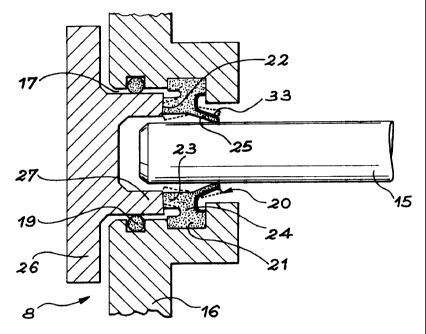Some of the information on this Web page has been provided by external sources. The Government of Canada is not responsible for the accuracy, reliability or currency of the information supplied by external sources. Users wishing to rely upon this information should consult directly with the source of the information. Content provided by external sources is not subject to official languages, privacy and accessibility requirements.
Any discrepancies in the text and image of the Claims and Abstract are due to differing posting times. Text of the Claims and Abstract are posted:
| (12) Patent: | (11) CA 2244528 |
|---|---|
| (54) English Title: | LEAKTIGHT FITTING FOR A SHAFT END |
| (54) French Title: | AJUSTEMENT ETANCHE POUR UNE EXTREMITE D'ARBRE |
| Status: | Expired |
| (51) International Patent Classification (IPC): |
|
|---|---|
| (72) Inventors : |
|
| (73) Owners : |
|
| (71) Applicants : |
|
| (74) Agent: | LAVERY, DE BILLY, LLP |
| (74) Associate agent: | |
| (45) Issued: | 2007-10-23 |
| (22) Filed Date: | 1998-08-04 |
| (41) Open to Public Inspection: | 1999-02-13 |
| Examination requested: | 2003-06-02 |
| Availability of licence: | N/A |
| (25) Language of filing: | English |
| Patent Cooperation Treaty (PCT): | No |
|---|
| (30) Application Priority Data: | ||||||
|---|---|---|---|---|---|---|
|
The present invention relates to a leaktight seal with a lip capable of gripping a shaft end and fitted behind a cap. When the cap is in place covering the shaft end and closing the housing, it presses on a stop flange of seal and pushes the lip outwards so that the rotation of the shaft end causes no wear to the seal. When the cap is removed, the housing remains open but the lip grips the shaft end and restores the leaktight seal. This fitting is of particular use for shaft ends fitted with a key slot used for manually rotating a rotating machine during the inspection phase of servicing, the shaft end being driven during normal use of the machine.
La présente invention porte sur un joint d'étanchéité à lèvre capable d'agripper l'extrémité d'un arbre et monté derrière un capuchon. Quand le capuchon est en place recouvrant l'extrémité de l'arbre et fermant le boîtier, il appuie sur une bride d'arrêt du joint et pousse la lèvre vers l'extérieur de façon à ce que la rotation de l'extrémité de l'arbre n'entraîne aucune usure de l'arbre. Quand le capuchon est retiré, le boîtier demeure ouvert mais la lèvre agrippe l'extrémité de l'arbre et restaure l'étanchéité du joint. Ce dispositif est particulièrement utile pour les extrémités d'arbre dotées d'un logement de clavette utilisé pour la rotation manuelle d'une machine rotative durant la phase d'inspection de la maintenance, l'extrémité de l'arbre étant entraînée durant l'utilisation normale de la machine.
Note: Claims are shown in the official language in which they were submitted.
Note: Descriptions are shown in the official language in which they were submitted.

For a clearer understanding of the status of the application/patent presented on this page, the site Disclaimer , as well as the definitions for Patent , Administrative Status , Maintenance Fee and Payment History should be consulted.
| Title | Date |
|---|---|
| Forecasted Issue Date | 2007-10-23 |
| (22) Filed | 1998-08-04 |
| (41) Open to Public Inspection | 1999-02-13 |
| Examination Requested | 2003-06-02 |
| (45) Issued | 2007-10-23 |
| Expired | 2018-08-06 |
There is no abandonment history.
| Fee Type | Anniversary Year | Due Date | Amount Paid | Paid Date |
|---|---|---|---|---|
| Application Fee | $300.00 | 1998-08-04 | ||
| Registration of a document - section 124 | $100.00 | 1998-10-08 | ||
| Maintenance Fee - Application - New Act | 2 | 2000-08-04 | $100.00 | 2000-07-28 |
| Maintenance Fee - Application - New Act | 3 | 2001-08-06 | $100.00 | 2001-07-18 |
| Maintenance Fee - Application - New Act | 4 | 2002-08-05 | $100.00 | 2002-07-31 |
| Request for Examination | $400.00 | 2003-06-02 | ||
| Maintenance Fee - Application - New Act | 5 | 2003-08-04 | $150.00 | 2003-07-28 |
| Maintenance Fee - Application - New Act | 6 | 2004-08-04 | $200.00 | 2004-07-21 |
| Maintenance Fee - Application - New Act | 7 | 2005-08-04 | $200.00 | 2005-07-28 |
| Maintenance Fee - Application - New Act | 8 | 2006-08-04 | $200.00 | 2006-07-25 |
| Final Fee | $300.00 | 2007-07-11 | ||
| Maintenance Fee - Application - New Act | 9 | 2007-08-06 | $200.00 | 2007-07-25 |
| Maintenance Fee - Patent - New Act | 10 | 2008-08-04 | $250.00 | 2008-07-28 |
| Maintenance Fee - Patent - New Act | 11 | 2009-08-04 | $250.00 | 2009-07-27 |
| Maintenance Fee - Patent - New Act | 12 | 2010-08-04 | $250.00 | 2010-07-26 |
| Maintenance Fee - Patent - New Act | 13 | 2011-08-04 | $250.00 | 2011-07-25 |
| Maintenance Fee - Patent - New Act | 14 | 2012-08-06 | $250.00 | 2012-07-23 |
| Maintenance Fee - Patent - New Act | 15 | 2013-08-05 | $450.00 | 2013-07-24 |
| Maintenance Fee - Patent - New Act | 16 | 2014-08-04 | $450.00 | 2014-07-24 |
| Maintenance Fee - Patent - New Act | 17 | 2015-08-04 | $450.00 | 2015-07-24 |
| Maintenance Fee - Patent - New Act | 18 | 2016-08-04 | $450.00 | 2016-07-20 |
| Maintenance Fee - Patent - New Act | 19 | 2017-08-04 | $450.00 | 2017-07-20 |
Note: Records showing the ownership history in alphabetical order.
| Current Owners on Record |
|---|
| SOCIETE HISPANO SUIZA |
| Past Owners on Record |
|---|
| LETURCQ, MICHEL MARIE MAURICE |